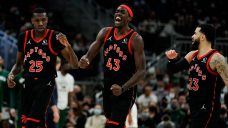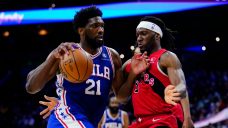The Toronto Raptors' path to success hasn’t changed much since the first game of the regular season.
It wasn’t even clear they were on one at the time.
It’s been a while, so allow me to refresh: the Raptors hosted the Washington Wizards in their first game at Scotiabank Arena in more than 18 months to kick off the 2021-22 campaign on Oct. 20.
It was a night full of feels, a hint at normalcy. The nostalgia meter was on high.
And the Raptors brought everyone back to earth by treating their fans to a rock fight.
They lost 98-83 to the Wizards in a game that on the surface seemed to bode poorly for a team that was projected to be on the fringes of the play-in tournament, at best.
After shooting just 30.9 per cent and 7-of-34 from three while coughing up 19 turnovers, it seemed even those modest expectations were optimistic.
How bad were the Raptors? They had lost a game in which they took 16 more field-goal attempts than their opponent by 15 points.
Not only that, but the Raptors also had a 19-7 edge in offensive rebounds and a 21-19 edge in turnovers.
Losing games while leading in those three categories?
It’s hard to do.
Turns out, the Raptors were on to something.
And the Raptors went on to prove it as the regular season wore on.
Two nights later, on the road against the Boston Celtics, the Raptors showed what a game can look like if they do everything needed to take more shots than their opponent -- and make a few of them, too.
They ran Boston off the floor at its home opener with a 35-point win -- the Celtics' worst loss of the season -- generated by a +18-shot margin, a 25-11 edge in offensive rebounds and a 21-10 advantage in turnovers.
The Raptors were in the early stages of establishing a formula they’ve adhered to all season:
More often than not, they grabbed more offensive rebounds, forced more turnovers and took more shots than their opponents and -- more often than not -- they won.
The Raptors took as many or more shots 69 out of 82 starts during the regular season and were 44-25 on those nights.
When they lost the so-called possession battle? They lost the games too, as they were 4-9 in the 13 games they had fewer field-goal attempts.
“I think it took a couple games, to be honest with you [to figure it out],” said Raptors forward Chris Boucher, who is one of five rotation players averaging at least two offensive rebounds a game this season. “… I think after realizing that offensive rebounding is something we can do every game, we started putting more emphasis on it. Then Precious [Achiuwa] started doing it too and we got Thad [Young] this year and Scottie [Barnes] and Khem [Birch]. I think it’s something we all saw we were good at.
“In practice, we realized we’re doing it to each other so we might as well do it to the other team and it really helped out. When you start watching the games and you see that you’ve got 47 shots to 37, that’s 10 more shots that you got just off offensive rebounds and that will win you games. We made it something important to us.”
At the other end of the roster, the likes of Fred VanVleet and Gary Trent Jr. were causing havoc with deflections and steals and ended up near the lead league in each category. Meanwhile, of the nine players in the NBA this season to have at least 1.5 offensive rebounds and 1.2 per game, three of them -- Young, Pascal Siakam and OG Anunoby -- played for Toronto
The Raptors didn’t have a game plan as much as they had a lifestyle. They lead the league in shot differential, as they averaged 6.9 more field attempts than their opponents.
The challenge now, as they get prepared for their first-round series against the Philadelphia 76ers on Saturday, is to have their approach stack up in the post-season.
How the Raptors do things is hardly a secret. Almost without fail, opposing coaches would point to managing the defensive glass and taking care of the ball as keys to winning against Toronto, but they’re the kind of details that can get lost playing the third game in four nights, or on the second night of a back-to-back. Likewise, focusing on defending in transition, another area key to how the Raptors like to attack.
They are exactly the kinds of details coaches drill down on during the post-season.
“It’s always a big factor,” said coach Nick Nurse. “Teams do a much better job of getting back [in transition]. They really do against us because we’re a team that generates a lot of offence out of fast break. This is gonna be a slugfest right here, this one coming up.”
So, what the Raptors are going to do is perhaps the most pressing question they face.
All the energy Toronto has put into forcing turnovers, generating second-chance points and scoring in transition papered over a few inconvenient truths: when the game slows down and the Raptors are forced to score in the half-court, they aren’t very good at it.
The Raptors ranked 26th in points per play in the half-court, per cleaningtheglass.com, and ranked 27th in effective field goal percentage and 21st in three-point shooting.
Remember how the Raptors are 4-9 this season in games where they don’t take more shots than their opponents?
This is why: they don’t always make enough of the ones they do get.
There is no cause for panic. The Raptors aren’t. They believe they can play to their identity against the Sixers who -- despite the presence of Joel Embiid -- are just an average defensive rebounding team. As well, Embiid and James Harden – by far the Sixers with the ball in their hands most of the time – are both prone to turnovers, averaging 6.5 giveaways between them.
“It’s a battle, right? They’re gonna try and limit those opportunities [on the offensive glass and via turnovers] and we’re gonna try and create those opportunities whether that’s creating deflections and steals, runouts on our defensive end, or whether that’s attacking the glass,” said VanVleet on Thursday. “I think there’s areas to do that with the switches, with the matchups with some of the size and the length that we have. I think being in sync and knowing when the shot’s going up gives you a better chance of offensive rebounding so there’ll be a flow to the game where we can send two or three guys to the glass, try to get some success.
“At the end of the day, there’s a value there, if we value it enough we’ll go get it and if it matters enough to us we’ll go get ‘em. I think that we’ll see, this is the most we’ve crashed the glass and put and emphasis on that since I’ve been here, so we’ll see how that works out for us in the playoffs. I’m confident that we can get it done.”
And if not? Do they have a plan B?
“Yeah, I mean, come on, it’s Nicky Nurse, baby,” said VanVleet. “In all seriousness, we’ve shown that we can win in a thousand different ways this year, there’s a lot of different ways to do it and we’ve explored just about all of them.”
Being at or close to full health could be the difference. VanVleet and OG Anunoby are two of the Raptors' most important three-point threats and both saw limited action due to injuries after the all-star break. Each is expected to be at or near 100 per cent after a week’s rest. Combined with Trent Jr., they give Toronto three dangerous perimeter threats which essential to space the floor in the half court.
Maybe that will be enough, or maybe they’ll have to figure out something else.
“We’ve had ugly wins, we’ve had good wins, we’ve had shootouts, we’ve had slugfests as coach said the other day,” VanVleet continued. “But I think that’s the versatility of being able to have different things that you can go to, but we gotta be who we are.
“At this time of year, you are who you are, you go out there and try do that to the best of your ability and see where it gets you.”







COMMENTS
When submitting content, please abide by our submission guidelines, and avoid posting profanity, personal attacks or harassment. Should you violate our submissions guidelines, we reserve the right to remove your comments and block your account. Sportsnet reserves the right to close a story’s comment section at any time.